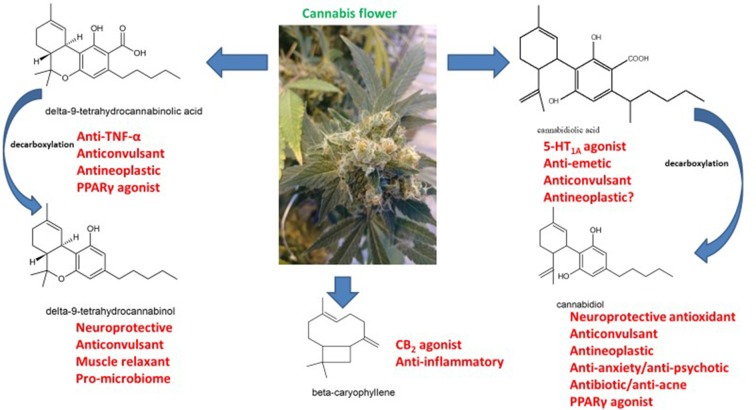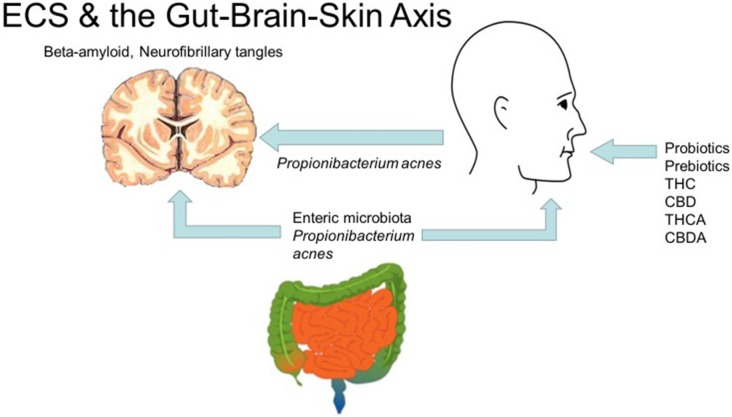Russo Ethan B.
Frontiers in integrative neuroscience, 2018
Abstract
Neurological therapeutics have been hampered by its inability to advance beyond symptomatic treatment of neurodegenerative disorders into the realm of actual palliation, arrest or reversal of the attendant pathological processes. While cannabis-based medicines have demonstrated safety, efficacy and consistency sufficient for regulatory approval in spasticity in multiple sclerosis (MS), and in Dravet and Lennox-Gastaut Syndromes (LGS), many therapeutic challenges remain. This review will examine the intriguing promise that recent discoveries regarding cannabis-based medicines offer to neurological therapeutics by incorporating the neutral phytocannabinoids tetrahydrocannabinol (THC), cannabidiol (CBD), their acidic precursors, tetrahydrocannabinolic acid (THCA) and cannabidiolic acid (CBDA), and cannabis terpenoids in the putative treatment of five syndromes, currently labeled recalcitrant to therapeutic success, and wherein improved pharmacological intervention is required: intractable epilepsy, brain tumors, Parkinson disease (PD), Alzheimer disease (AD) and traumatic brain injury (TBI)/chronic traumatic encephalopathy (CTE). Current basic science and clinical investigations support the safety and efficacy of such interventions in treatment of these currently intractable conditions, that in some cases share pathological processes, and the plausibility of interventions that harness endocannabinoid mechanisms, whether mediated via direct activity on CB1 and CB2 (tetrahydrocannabinol, THC, caryophyllene), peroxisome proliferator-activated receptor-gamma (PPARγ; THCA), 5-HT1A (CBD, CBDA) or even nutritional approaches utilizing prebiotics and probiotics. The inherent polypharmaceutical properties of cannabis botanicals offer distinct advantages over the current single-target pharmaceutical model and portend to revolutionize neurological treatment into a new reality of effective interventional and even preventative treatment.
Keywords
Alzheimer disease; Parkinson disease; brain tumor; cannabis; epilepsy; microbiome; pain; traumatic brain injury.
Figures

The pharmacology of phytocannabinoids pertinent to treatment of neurodegenerative disorders (molecular structures drawn by ER with ACD/ChemSketch 2015.2.5).

Cannabis, the endocannabinoid system and the gut-brain-skin axis (diagrams of brain, gut by Mikael Hagstrom, face by Mouagip, all public domain).
| PMID: | 30405366 |
|---|---|
| PMCID (Free PMC Article): | PMC6200872 |
| DOI: | 10.3389/fnint.2018.00051 |
| Category: | General properties of Cannabidiol |
| Category: | General properties of Cannabidiolic Acid |
Articles similar to "Cannabis Therapeutics and the Future of Neurology."
- The properties of Cannabidiol: The cannabinoid system and immune modulation. (Studies on the effects of marijuana smoking have evolved into the discovery and description of the endocannabinoid system...)
- The properties of Cannabidiol: Medicinal Uses of Marijuana and Cannabinoids. (In the past two decades, there has been increasing interest in the therapeutic potential of cannabis and single cannabinoids, mainly cannabidiol (CBD) and delta-9-tetrahydrocannabinol (THC)...)
- The properties of Cannabidiol: Cannabidiol Reduces Neuroinflammation and Promotes Neuroplasticity and Functional Recovery After Brain Ischemia. (This study investigated the effects of cannabidiol (CBD), a non-psychotomimetic phytochemical present in Cannabis sativa, on the cognitive and emotional impairments induced by bilateral common carotid artery occlusion (BCCAO) in mice...)
- The properties of Cannabidiol: Nonpsychotropic cannabinoids, abnormal cannabidiol and canabigerol-dimethyl heptyl, act at novel cannabinoid receptors to reduce intraocular pressure. (The objective of our study was to examine the pharmacology of the intraocular pressure (IOP)-lowering actions of the behaviorally inactive cannabinoids, abnormal cannabidiol (abn-CBD), and a cannabigerol analog, cannabigerol-dimethyl heptyl (CBG-DMH), in comparison to that of the nonselective cannabinoid 1 receptor (CB(1)R) and CB(2)R agonist, WIN55,212-2, in Brown Norway rats...)
- The properties of Cannabidiolic Acid: Pharmacological data of cannabidiol- and cannabigerol-type phytocannabinoids acting on cannabinoid CB 1, CB 2 and CB 1/CB 2 heteromer receptors. ( Recent approved medicines whose active principles are Δ9Tetrahidrocannabinol (Δ9-THC) and/or cannabidiol (CBD) open novel perspectives for other phytocannabinoids also present in Cannabis sativa L... Results here reported and the recent elucidation of the three-dimensional structure of CB1 and CB2 receptors help understanding the mechanism of action that might be protective and the molecular drug-receptor interactions underlying biased signaling. )
- The properties of Cannabidiolic Acid: Analysis of cannabinoids in commercial hemp seed oil and decarboxylation kinetics studies of cannabidiolic acid (CBDA). (Hemp seed oil from Cannabis sativa L... Results here reported and the recent elucidation of the three-dimensional structure of CB1 and CB2 receptors help understanding the mechanism of action that might be protective and the molecular drug-receptor interactions underlying biased signaling. )
- The properties of Cannabidiol: Cannabis sativa: Much more beyond Δ 9-tetrahydrocannabinol. (Cannabis is the most used illicit drug worldwide and its medicinal use is under discussion, being regulated in several countries... Results here reported and the recent elucidation of the three-dimensional structure of CB1 and CB2 receptors help understanding the mechanism of action that might be protective and the molecular drug-receptor interactions underlying biased signaling. )
- The properties of Cannabidiol: Molecular Pharmacology of Phytocannabinoids. (Cannabis sativa has been used for recreational, therapeutic and other uses for thousands of years... Results here reported and the recent elucidation of the three-dimensional structure of CB1 and CB2 receptors help understanding the mechanism of action that might be protective and the molecular drug-receptor interactions underlying biased signaling. )
- The properties of Cannabidiolic Acid: A systematic review of minor phytocannabinoids with promising neuroprotective potential. (Embase and PubMed were systematically searched for articles addressing the neuroprotective properties of phytocannabinoids, apart from cannabidiol (CBD) and Δ9 -tetrahydrocannabinol, including Δ9 -tetrahydrocannabinolic acid, Δ9 -tetrahydrocannabivarin, cannabidiolic acid (CBDA), cannabidivarin (CBDV), cannabichromene (CBC), cannabichromenic acid (CBCA), cannabichromevarin (CBCV), cannabigerol (CBG), cannabigerolic acid (CBGA), cannabigerivarin (CBGV), cannabigerovarinic acid, cannabichromevarinic acid (CBCVA), cannabidivarinic acid (CBDVA), and cannabinol (CBN)... Results here reported and the recent elucidation of the three-dimensional structure of CB1 and CB2 receptors help understanding the mechanism of action that might be protective and the molecular drug-receptor interactions underlying biased signaling. )
- The properties of Cannabidiol: Pharmacology of cannabinoids in the treatment of epilepsy. (The use of cannabis products in the treatment of epilepsy has long been of interest to researchers and clinicians alike; however, until recently very little published data were available to support its use... Results here reported and the recent elucidation of the three-dimensional structure of CB1 and CB2 receptors help understanding the mechanism of action that might be protective and the molecular drug-receptor interactions underlying biased signaling. )
- The properties of Cannabidiol: Pharmacokinetics and metabolism of the plant cannabinoids, delta9-tetrahydrocannabinol, cannabidiol and cannabinol. (Increasing interest in the biology, chemistry, pharmacology, and toxicology of cannabinoids and in the development of cannabinoid medications necessitates an understanding of cannabinoid pharmacokinetics and disposition into biological fluids and tissues... Results here reported and the recent elucidation of the three-dimensional structure of CB1 and CB2 receptors help understanding the mechanism of action that might be protective and the molecular drug-receptor interactions underlying biased signaling. )
- The properties of Cannabidiol: Cannabidiol (CBD). (Cannabis sativa or Indian hemp (subfamily Cannaboideae of family Moraceae) is an annual herbaceous plant, native to central and western Asia, cultivated for medicinal properties and for hemp, which is a natural textile fiber... Results here reported and the recent elucidation of the three-dimensional structure of CB1 and CB2 receptors help understanding the mechanism of action that might be protective and the molecular drug-receptor interactions underlying biased signaling. )
- The properties of Cannabidiol: Exogenous cannabinoids as substrates, inhibitors, and inducers of human drug metabolizing enzymes: a systematic review. (Exogenous cannabinoids are structurally and pharmacologically diverse compounds that are widely used... Results here reported and the recent elucidation of the three-dimensional structure of CB1 and CB2 receptors help understanding the mechanism of action that might be protective and the molecular drug-receptor interactions underlying biased signaling. )
- The properties of Cannabidiol: Flavonoid glycosides and cannabinoids from the pollen of Cannabis sativa L. (Chemical investigation of the pollen grain collected from male plants of Cannabis sativa L... Results here reported and the recent elucidation of the three-dimensional structure of CB1 and CB2 receptors help understanding the mechanism of action that might be protective and the molecular drug-receptor interactions underlying biased signaling. )

























































